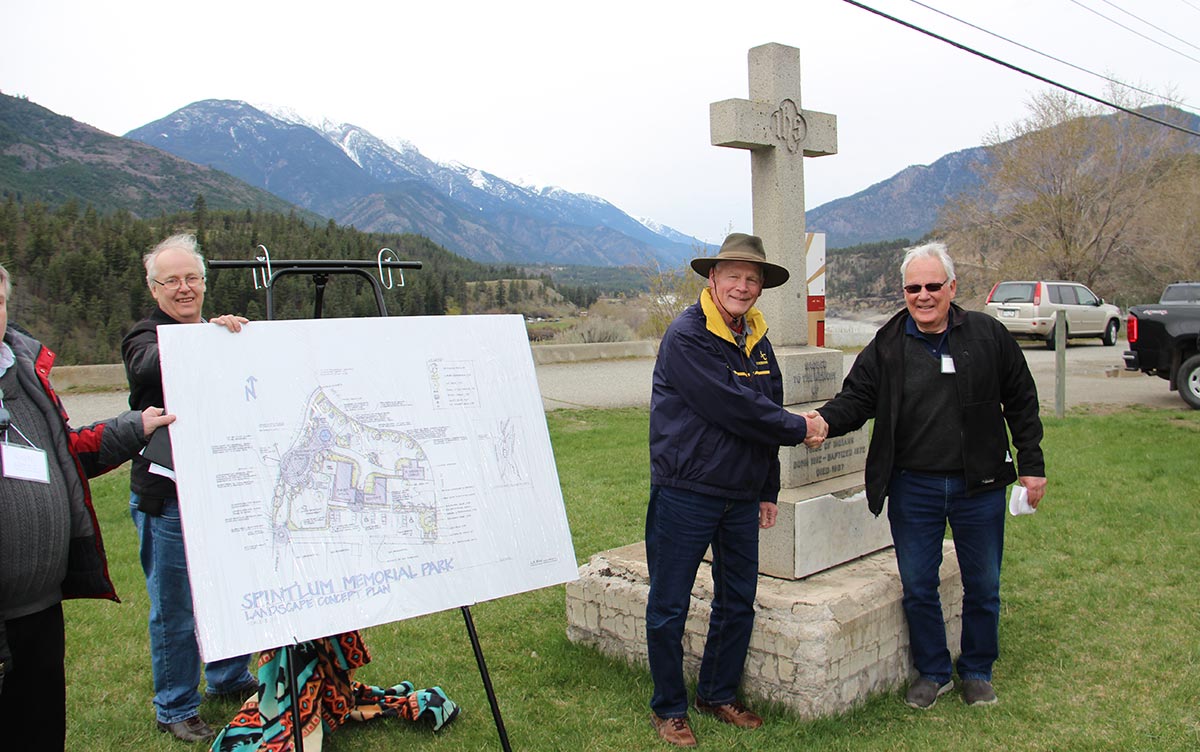Above: Cecil Salmon (right, a direct descendent of Chief Cexpe’nthlEm) and Dale Snyder (a descendant of Henry Snyder) unveiling the design for a revitalized memorial precinct in 2018.
(LYTTON) One of the great mysteries of British Columbia history is where celebrated Indigenous leader and peace-maker Chief Cexpe’nthlEm is buried. Is he beneath the memorial to him on the grounds of the Anglican Church complex of St. Barnabus in Lytton? Or was this co-founder of modern B.C. laid to rest somewhere in the hills above the confluence of the Thompson and Fraser Rivers?
At least part of the mystery may be solved this July when an archaeological geophysical investigation of the precinct around the memorial will be conducted as part of the Chief Cexpe’nthlEm Memorial Precinct Revitalization Project.
“This is an important first step in building a fitting memorial to a great leader,” says Lytton First Nation Chief Janet Webster.
“We’re very eager to see the results of the survey and whether or not we find any human remains — be they Chief Cexpe’nthlEm’s or any other of our People.”
Cexpe’nthlEm (1812-1887, known to non-Indigenous Peoples as David Spintlum) was a
tireless advocate for peace in 1858 when tens of thousands of gold-seeking miners flooded into his people’s traditional territory. Conflict arose and threatened to spread across the border into U.S. territory, which would have likely resulted in American military intervention and potentially the annexation of the B.C. Mainland.
Cexpe’nthlEm convinced the people to choose the path of peace and in August 1858, he brought an end to hostilities with Henry Snyder, an American militia captain, ending what became known as the Canyon War. When he died in 1887, a memorial to Cexpe’nthlEm was built and placed on the grounds of St. Barnabus, next to the Parish Hall in Lytton, above the site where he and Snyder made peace in 1858. It’s a relatively modest stone cross atop a concrete base.
But is Chief Cexpe’nthlEm buried there? Are there other people interned on the grounds? Are there any artifacts? All these questions have to be answered before the project to build a substantial memorial complex celebrating Cexpe’nthlEm’s legacy can commence.
So the project Task Force hired GeoScan Subsurface Surveys of Vancouver to conduct an archaeological geophysical investigation of the precinct grounds. It will use Ground Penetrating Radar and a Magnetic Survey Technology to determine if there are any human remains, artifacts or unknown structures on the grounds.
“We are really excited about this project from both historical and technological perspective. Although the raised question is both important and difficult to answer, it is our job to do everything within our constraints to extract all information we can without digging into the soil,” said Geoscan’s Peter Takacs.
“We’re using the best available techniques from the non-destructive survey field to create images of the subsurface to potentially reveal information about archaeologically and culturally significant features. We will be using ground penetrating radar and magnetic gradiometers, which are already widely used methodologies for preliminary archaeological investigations throughout the world.”
The Chief Cexpe’nthlEm Memorial Precinct Revitalization Project has been in development since 2008. Funds provided by BC Hydro paid for a design of the precinct developed by LA West Associates of Kamloops. The design was officially unveiled in 2018 by Cecil Salmon (a direct descendent of Chief Cexpe’nthlEm) and Dale Snyder (a descendant of Henry Snyder) on the 160th anniversary of the end of the Canyon War.
Task Force Member Mayor Jan Polderman of Lytton says celebrating and articulating the story of Cexpe’nthlEm and Snyder is important as B.C. enters a new phase of First Nations reconciliation.
“It’s a great example of how people, even in times of great stress and turmoil, can find common ground and work together to build something that can benefit everyone,” said Polderman.
“We’re excited to see the results and look forward to creating a new heritage tourism asset for Lytton and the Fraser Canyon.”
The Chief Cexpe’nthlEm Memorial Precinct Restoration Project is a partnership between the Lytton First Nation, Village of Lytton, the Anglican Parish and the New Pathways to Gold Society (NPTGS).
Project management support is being provided by NPTGS, a non-profit organization committed to developing local economies in the Hope to Barkerville corridor through heritage tourism development, First Nations reconciliation and Multiculturalism.
“Chief Cexpe’nthlEm was a great leader. This is a significant step in recognizing the Indigenous Peoples’ leadership in creating the society we now know as B.C.,” said NPTGS Indigenous Co-Chair Cheryl Chapman.
“This project also aligns with the province’s strategic plan to build our local economies by providing tourists with more Indigenous experiences.”
NPTGS Co-Chair Terry Raymond says once the project is completed, it will provide Lytton and the Fraser Canyon with a significant new heritage tourism asset that will generate economic benefits for the community.
“People will get off the highway and stop in Lytton to learn more about Chief Cexpe’nthlEm and visit this beautiful site where the two rivers meet. They’ll also explore the museums, restaurants, businesses and other attractions of Lytton, a key heritage community in our province,” says Raymond.
“Cexpe’nthlEm called this place his centrepost. We hope the Chief Cexpe’nthlEm Memorial Precinct Revitalization Project creates a new centrepost that attracts people from around the globe who want to experience a more complete narrative of our shared history.”
The project partners gratefully acknowledge the financial assistance of the Government of British Columbia and the Ministry of Tourism, Arts and Culture.


